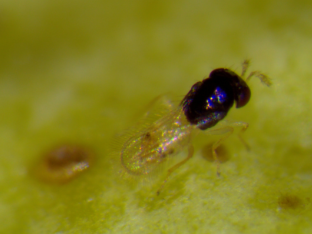Thripobius Thripobius javae
Thripobius javae (T. javae) is a native Australian parasitic wasp that is utilised for biological control of Greenhouse thrips (Heliothrips haemorrhoidalis). Whilst not a major pest, other beneficials are not able to properly control Greenhouse thrips, making T. javae a necessary product where this pest occurs. Greenhouse thrips is also difficult to control with chemicals.
Description and biology
Thripobius javae wasps are about 0.5-0.8mm in length. The head and thorax are shiny and black in colour. It has a yellow abdomen with 2 posterior dark spots, and yellow legs and antennae. Both Australian and Brazilian strains of T. javae are uniparental, which means nearly all individuals are female.
T. javae wasps lay eggs inside the body of Greenhouse thrips larvae. First or early second instar of thrip larvae are the most susceptible stages for parasitism. When the parasite larvae is fully grown, it kills the thrip larvae, pupates inside the thrip larval skin, and turns black in colour when fully developed. Average fecundity is 25 eggs per female, but some studies have reported 60-100 eggs/female. With an optimum temperature of 25-30°C, the life cycle takes 2-3 weeks. The adult lives for 4-5 days.
Suitable crops
Greenhouse thrips has more than 100 hosts, mainly greenhouse plants, tropical plants and some field crops. Some greenhouse plants that are highly susceptible to Greenhouse thrips include azalea, begonia, croton, cyclamen, ferns, orchids, palm, roses and avocado. Greenhouse thrip also attacks a range of outdoor crops in warm humid environments, including avocado, ficus, camelia, cymbidium and other orchid varieties, viburnum, citrus, coffee, macadamia, mango and many other ornamental plants.
When to release
Release can occur at any time when Greenhouse thrips are active. It is important before taking any action to look carefully for thrips activity to be certain that they are present. Damage on the leaves, flowers and fruits is visible for a long time after the thrips activity has occurred.
How to release
T. javae are sent as loose pupae in plastic vials (100 pupae/vial). They can be sprinkled over the top of foliage in soil-grown crops, or in hydroponics, open the vial and leave it resting sideways in the crop canopy so they can fly freely onto the plants once emerged. Do not place vials/pupae on the ground or pupae may be eaten by ants. If ants are present, try to control them with baits prior to release. Bio boxes can be used to hang the pupae in the crop.
Release rates
These parasites can only be produced in moderate numbers. It is important to release small amounts multiple times aiming for establishment on each property over a period of several years. Our Biological Services Consultants can advise suitable release rates for each circumstance.
Storage
Ideally, release into affected areas as soon as the product is received. The pupae can be held at 6-10°C for several days without a reduction in quality if conditions are unsuitable.
Chemical use
Contact insecticides including insecticidal soaps, narrow-range oils, neem oils and pyrethrins have either low toxicity or low residual activity to T. javae. They could be used prior to release. Try not to spray for at least 3 weeks after releasing wasps each time (preferably longer).
T. javae is sensitive to many pesticides, particularly pyrethroids, organophosphates and neonicotinoids. Residues on foliage and greenhouse structures may remain toxic for many weeks and negatively impact on their survival and ability to effect control. Check side-effects charts carefully and avoid using pesticides before and during use unless they are known to be safe. Contact Biological Services for specific information.
Ordering and accounts
Orders are sent via express courier services on Monday or Tuesday of each week, and usually arrive within a couple of days. Orders received after noon on Tuesday are sent the following Monday. Freight is charged at cost. Accounts are sent at the end of each month, and can be paid by EFT, BPay, cheque or postal order.





